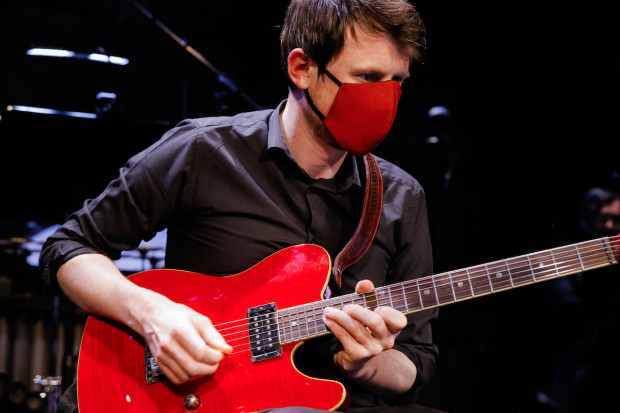
Hard Rain Soloist Ensemble
Ireland Past, Present and Future?
The Hard Rain Soloist Ensemble (HRSE), founded by composer Greg Caffrey in 2013, is Northern Ireland’s newest contemporary music ensemble. At the Crescent Arts Centre earlier this summer, their concert ‘Involute’ featured works by seven Irish (male) composers, plus works by Dutch composer Ton Bruynèl (1934–1998) and German composer Hans Werner Henze (1923–2012).
Throughout the concert, different aspects and interpretations of ‘Irishness’ were displayed. David Byers’ Strum, Strum and be Hang’d drew upon Ireland’s history. Based on a quote from Wolfe Tone at the 1792 Belfast Harp Festival, it featured a dialogue between tape machine and cello (performed by David McCann). The tape itself sounded rather like a music box, and the speech in the soundscape allowed Byers to connect the audience to the past in a more concrete way. There was also a notable use of singable cello melodies, and the contrast between the tape and cello led us down a more absorbing harmonic path, gradually allowing for asynchronous dissonances to appear.
Greg Caffrey’s …for peace comes dropping slow (along with Corcoran’s Nine Looks at Pierrot) were specifically commissioned by the HRSE. The work takes inspiration from Yeats’ ‘The Lake Isle of Innisfree’, but – with its tense passages and runs between cello and piano – Caffrey’s piece seemed to paint a much darker picture of an Irish past (or future?) than Byers did.
Extreme level
Flautist Aisling Agnew performed the 2004 version of John Buckley’s 2 Fantasias for Alto Flute, a piece described as a ‘lament with Irish flair’. Here there was a deconstruction of Irishness through the exaggeration of trills and grace notes – to an extreme level. Agnew navigated this expertly, particularly when it came to the second theme where the work was frantic and scattered.
Kevin O’Connell’s A Battuta was a reinterpretation of source materials. The composer referred to the piece as an exploration of ‘a shape of melody’ and this evoked a mid-dream quality. The initial melody is passed between each of the instrumentalists but slightly altered or ‘misremembered’ from the first theme that was played. There were comedic elements at play here as each instrument latches onto a different aspect – the woodwinds with an approximation of the harmonic intervals, and the strings with an approximation of the dance-like rhythms.
Seascape
There were however more confusing aspects to the concert that felt misrepresented. Ton Bruynèl’s Save the Whale for contrabass clarinet and tape was a surface-level examination of a seascape, and the tape elements felt under-composed in comparison to the interpretation of the graphic score by clarinet player Sarah Watts.
Rhythmically stubborn call and response passages, such as where the ‘whale’ and the ‘ship’ begin their conflict, were dissected with ease, but there were times when Watts was anchored too heavily to the atmosphere of the seascape to land a more nuanced interpretation. This feeling was also present in the tape elements of Strum, Strum and Be Hang’d, which might have been alleviated by a more creative presentation of the tracks via live electronics or audiovisual presentation.
Interactions
Throughout the concert there were great interactions between the instrumentalists. The most obvious example was during Hans Werner Henze’s Sonata für Sechs Spieler. Pianist Daniel Browell was able to use the muddy chords as an undercurrent for the ensemble rather than something that would suffocate. McCann and violin/viola player Ciaran McCabe would comment as a duo with melodic mimicking. The piece flicks between these floating melodieswarping together and rhythmically tight playing.
Frank Corcoran’s Nine Looks at Pierrot seemed slightly fragmented. Corcoran likened the piece to ‘short time bombs’ and ‘a funeral’. The piece itself did not have much in the form of unity between these nine different ‘looks’, and the performance felt rather crowded for what the pieces were.
Ian Wilson’s Involute (Unterwelt part 2) – inspired by Orpheus – was often violent in its rhythm and dissonance, but was then soothed by swirling woodwind passages that left open-ended ‘resolutions’.
Piers Hellawell’s Let’s Dance (performed by Alex Petcu) was another example of virtuosity. In a piece described by Hellawell as ‘a kind of Slavic romp’, Petcu’s playing established not only the dance-like qualities of the rhythm, but also extracted the more meditative sounds that lurked underneath the surface, particularly in the vibraphone.
The Hard Rain Soloist Ensemble presented a concert of compositional variety without losing the synergy of their group. The Sonata für Sechs Spieler in particular was an impressive display of how unified the ensemble could be in their sound. But they also presented a concert that asked questions, most importantly, what do we think is the Ireland of the past, present and future and does it matter? The answer may evade us, but the programme gave multiple perspectives, whether the exaggerated flourishes of Buckley or the asynchronicity of Byers.
Hard Rain Soloist Ensemble’s ‘Involute’ concert took place on 12 May 2018 at the Crescent Arts Centre, Belfast. For upcoming HRSE concerts, visit www.hardrainensemble.com.
–
This review is published as part of a new scheme for writers about music in Northern Ireland. The Journal of Music Northern Ireland Music Writer Mentoring Scheme is supported by the Arts Council of Northern Ireland and was launched in January 2018. Over the year, the editorial team of The Journal of Music will work with four new writers towards publication. The scheme participants are Laura Sheary, Marc Gregg, Stevie Lennox and Aine Cronin-McCartney. Find out more about them here.
This is the third mentoring scheme developed by The Journal of Music, following successful projects in Galway City and County Clare. For further details on the schemes, please visit https://goo.gl/QY83ga.
Published on 15 August 2018
Marc Gregg is a tenor from Lisburn. He studied music at Goldsmiths, University of London, and in 2018 took part part in the Journal of Music/Arts Council of Northern Ireland Music Writer Mentoring Scheme. He currently hosts a new programme called Soap Opera on BBC Ulster. Visit https://www.bbc.co.uk/sounds/play/m0000wvx.

















